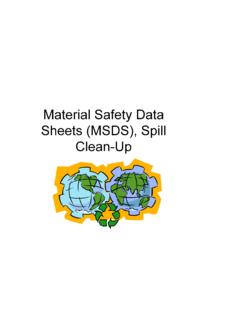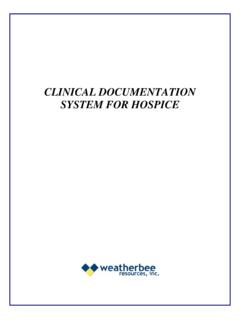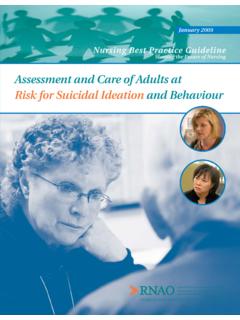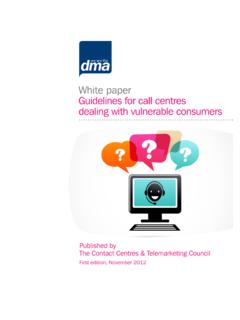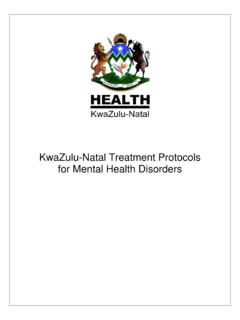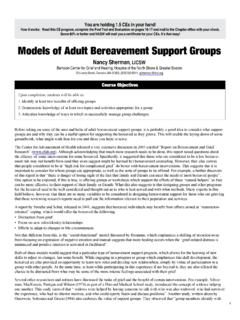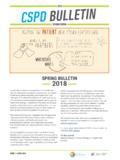Transcription of RM001A Performance Improvement Plan
1 Hospice of Rutherford County Policies and Procedures _____ Category: Risk Management Code: RM 001A Subject: Performance Improvement Plan Page: 1 of 8 Policy Date: 03/05/03 Revised: 07/06, 11/08 Approved: Date: Policy: Hospice of Rutherford County s Performance Improvement plan is designed to monitor, evaluate and improve the quality, appropriateness and outcomes of care, treatment and services by: Planning, designing, measuring, assessing, and improving new or revised processes of patient care and service Identifying opportunities through continuous assessment of systems and processes of care using a collaborative, interdisciplinary focus Implementing solutions and actions which will bring about desired change Facilitating a positive patient outcome Maintaining a safe environment for staff, patients and visitors Reporting information to the Board of Directors they need to fulfill their responsibility for the quality of patient care and safety Meeting state and federal regulatory guidelines and accreditation standards for quality assurance and Performance Improvement .
2 The Performance Improvement Plan, established by the management of Hospice and the interdisciplinary Performance Improvement Committee with the support and approval of the Board of Directors provides the mechanism to monitor patient care, treatment and services with the goal of identifying and resolving any processes, functions and services that may adversely impact patient care, treatment and services. The primary goal of the Performance Improvement Plan is to continuously and systematically improve patient care, treatment and services. To achieve this goal, Hospice s Performance Improvement activities shall be interdisciplinary, collaborative and organization-wide, including services provided under contractual agreement. Process design shall focus on the: organization s mission needs of those served, staff and others use of clinically sound, current data use of sound business practices use of results of Performance Improvement , patient safety and risk reduction activities _____ Category: Risk Management Code: RM 001A Subject: Performance Improvement Plan Page: 2 of 8_____ Procedures I.
3 Scope of Activities The Performance Improvement Plan is designed to assess and improve the quality of care provided and safety practices throughout Hospice. The plan shall include monitoring and evaluation of: (1) patient care provided directly and by arrangement and (2) organizational activities provided. The Plan will encompass: 1. Ethics, Rights and Responsibilities 2. Provision of Care, Treatment and Services 3. Medication Management 4. Surveillance, Prevention and Control of Infection 5. Improving Organizational Performance 6. Leadership 7. Management of the Environment of Care 8. Management of Human Resources 9. Management of Information The focus of Performance Improvement activities includes but is not limited to: Persons served: (patient, caregiver, community bereavement client, referring physician, etc.) Services: (nursing, social work, personal care, counseling, medical, volunteer, therapy, etc.)
4 Clinical Activities: (observation and assessment, coordination of care, referrals, medication administration, wound care, catheter care, teaching activities, counseling, etc.) Disciplines: (physician, nurse, hospice aide, social worker, chaplain, counselor, volunteer, etc.) Contract services: (therapy, oxygen, durable medical equipment, patient transportation, etc.) Levels of care: (routine home care, respite, in-patient care, continuous home care) Site of care: (home, skilled nursing and assisted living facilities, Hospice House, hospital, etc.) II. Organization: A. Board of Directors 1. The Board of Directors is responsible for the quality of patient care. 2. The Board requires staff, through the Executive Director and the interdisciplinary Performance Improvement Committee, to implement and report on activities and mechanisms for monitoring, assessing and evaluating patient safety practices and quality of patient care, for identifying and resolving problems and for identifying opportunities to improve patient care, service and Performance throughout the organization.
5 3. The Board, through the Executive Director, provides resources and support systems for the Performance Improvement functions and risk management functions related to patient care, treatment and services, and safety. _____ Category: Risk Management Code: RM 001A Subject: Performance Improvement Plan Page: 3 of 8_____ 4. The Board, through the Executive Director, assigns staff to be responsible for the Performance Improvement Plan (PIP) and projects. B. Executive Director The Executive Director assigns and supervises the Compliance Officer. C. Compliance Officer 1. The Compliance Officer is responsible for: (a.) coordination and implementation of the annual PIP Plan and on-going projects and (b.) collection, management, and report of data, projects and outcomes. 2. The Compliance Officer reports directly to the Executive Director and coordinates the activities of the Professional Advisory Committee and the Performance Improvement Committee.
6 3. The Compliance Officer is responsible for employee education regarding responsibility and involvement in Performance Improvement activities and the PIP Plan. D. Performance Improvement Committee 1. The Performance Improvement Committee is responsible for the identification and resolution of problems and for identifying opportunities to improve patient care, service and Performance throughout the organization. Methodology includes: Study processes to identify steps in process where there is, or may be, undesirable variation. Identify possible effects and severity of effects on patients, clients, community and employees. For most critical effects, conduct root cause analysis. Redesign the process and/or systems to minimize risks or protect patients from effects of undesirable variation. Test and implement redesigned process. Identify and implement measures of effectiveness of redesigned process.
7 Implement a strategy for maintaining the effectiveness of redesigned process over time. 2. The PI Committee may serve as the Performance Improvement Team or may appoint a team to plan and implement a specific Improvement project. The Team will be composed of employees who are familiar with the concern being investigated, and may include clinical and/or administrative staff and/or volunteers. The Performance Improvement Team will report all results in the form of minutes to the Compliance Officer. The PI Committee shall ensure that ongoing monitoring includes: (a) at least one important aspect related to service provided and (2) one related to an administrative aspect of function or service _____ Category: Risk Management Code: RM 001A Subject: Performance Improvement Plan Page: 4 of 8_____ III. Methodology A.
8 Hospice uses the Plan, Do, Study, Act Model of Improvement PDSA Goals What are we trying to accomplish? (AIM) How will we know that a change is an Improvement ? (MEASURE) What changes can we make that will result in an Improvement ? (CHANGE) PLAN THE Improvement ACT TO MAINTAIN THE GAIN DO THE Improvement STUDY THE RESULTS PLAN: Objective and valid Performance measures are identified for monitoring and assessing processes and outcomes of care including those affecting a large percentage of patients, and/or place patients at serious risk if not performed well, or performed when not indicated, or not performed when indicated; and/or have been or likely to be problem prone. Performance measures are based on current knowledge and clinical experience and are structured to represent interdisciplinary processes as appropriate.
9 Data will be collected from internal sources and external sources. The following data sources may be used in the development of Performance measures; Staff opinions and needs Staff perceptions of risks to patients and suggestions for Improvement Outcomes of processes or services, including incident reports Performance measures from approved internal and external databases Infection control surveillance and reporting _____ Category: Risk Management Code: RM 001A Subject: Performance Improvement Plan Page: 5 of 8_____ Patient and caregiver perceptions of care (satisfaction surveys) Risk management Utilization review Patient demographics and diagnoses Performance measures for processes that are known to risk safety of patients or associated with sentinel events will be routinely monitored. Performance measures related to the following processes are monitored with approval and at the suggested frequency of the PI Committee.
10 Data from incident reports and worker s compensation claims Known problem prone processes Medication use, including adverse reactions/errors Sentinel events Timeliness of assessments and evaluation of services Appropriateness of treatment Patient plan of care and goals Assessment of treatment outcomes Patient/caregiver/representative education Infection control practices Staff in-service education and training Patient/caregiver, attending physician and staff satisfaction Appropriateness, timeliness and effectiveness of pain and symptom management Care provided to high-risk populations Appropriateness, timeliness and adequacy of documentation Medication management Staffing effectiveness Benchmarks or thresholds that trigger further assessment and evaluation are established. Undesirable patterns or trends in Performance are analyzed.

